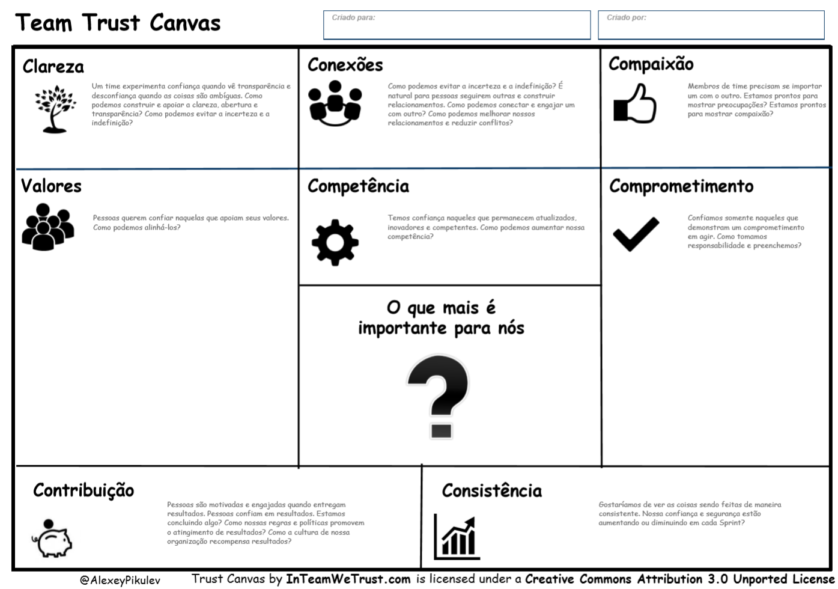Team Canvas
The Team Canvas is Business Model Canvas for teamwork. It is a free tool for leaders, facilitators and consultants to organize team alignment meetings and bring members on the same page, resolve conflicts and build productive culture, fast.
As a leader or facilitator, you experience moments when you need to bring team members together, clarify their goals, figure out their motivations and help them to be more aligned and productive.
Use Team Canvas to start a structured conversation with the team and bring everyone on the same page. Groups that go through Team Canvas sessions report higher clarity and alignment, with less friction and conflict. In the long run, use Team Canvas to start shaping the team culture at your company or collective.
If you want to use Team Canvas, you might like the Alex Ivanov approach as he explains in Session Lab:
Running the session – Introduce the team canvas as a tool to align the team members and get better at understanding goals, roles and values of your team.
1. People & Roles [5 minutes] – Ask people to put their names on stickies, as well as their roles. If a person has multiple roles, use separate post-its.
2. Common goals [10 minutes] – Ask the team to agree on common goals.
3. Personal goals [5 minutes] – Ask the team members about the individual goals they have for the project.
4. Purpose [10 minutes] – Ask the team to go one step beyond their common goal, and ask them why they do what they do.
5. Values [10 minutes] – Ask the team what are the core values – the most important principles – that they want to share within the team. The team should agree on values, so everyone accepts the final set.
6.Strengths & Assets [15 minutes] – Ask the team to share the key pieces of skills (both hard skills and soft skills) and assets available within the team. Don’t dismiss ‘insignificant’ stuff. You might find that the team has capacity for martial arts, running marathons or persuading people. Encourage people to share something about themselves, as well as note important qualities they see in their teammates.
7. Weaknesses & Development Areas [15 minutes] – Ask the team to share the key weaknesses and areas for improvement that they see in themselves, as well as obstacles they face as a team. Make an accent on reporting what people can find in themselves, rather than discussing other’s weaknesses.
8. Needs & Expectations [10 minutes] – Ask the team to express the needs they have in order to be successful. Think of this as a follow up to previous two sections: once team members expressed their strengths and weaknesses, they should be able to express the needs they have to amplify strengths and be at their best despite the weaknesses.
9. Rules & Activities [10 minutes] – Ask the team to agree on common rules and activities. Think of this as of outcome of the previous sections: a concrete set of rules and activities they want to implement.
Wrap up [5 minutes] – As you close The Team Canvas workshop, ask the team members to tell about one single most important insight that they gained during the workshop.
Tips for running this activity online
- Pick an online whiteboard tool that allows to use a large, zoomable canvas.
- Set up each topic at a different area of the board, spread them out just like you would do it on a the walls of a room.
- Invite participants to zoom in and visit each section and add their ideas.
- If you’re not using an online whiteboard, we’d recommend using a collaboration tool such as Google Docs to collect the information for each step under a separate heading. Invite everyone into the same document but be very clear in regards to editing rights.
- When facilitating group discussion, we’d recommend that participants use non-verbal means to indicate they’d like to speak. You can use tools like Zoom’s nonverbal feedback tools, a reaction emoji, or just have people put their hands up.The facilitator can then invite that person to talk.
Checkout other business canvases in our Canvas Database










